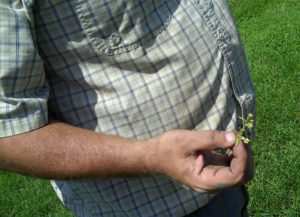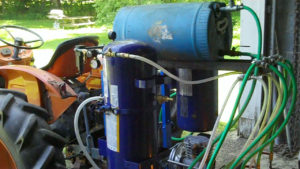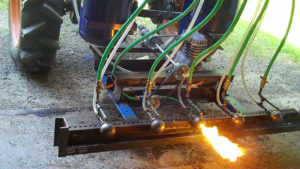Fighting the Weeds with Fire and French Fry Oil
In 2006, Flying Rabbit Farm was under water. “We rode the canoe up over the railroad tracks,” Dave Dolan said. “Your head would’ve been under water.” Not to mention the rows of wheat and kale on either side of us.

Galinsoga is Flying Rabbit Farm’s most problematic weed. Photo by Annie Bass
Dave and Mary Dolan have been farming this land for seven years, in a small-scale organic operation that includes collards, kale, chard, and baby lettuce mix for wholesale, and a wide variety of offerings, including tomatoes, corn, and chicken eggs, for the family and their neighbors. After 20 years of farming in three locations, they’ve worked out most of the kinks.
They used to sell directly at a New York City Green Market, but with two part-time jobs, one child, and environmental concerns about mileage, they’ve switched to wholesale, with restaurants near the farm in Otego, NY, and with Regional Access in Ithaca, NY. Nieces and nephews provide seasonal help such as weeding and harvesting. And they’ve got the baby lettuce system down to a science, with Mary harvesting and Dave washing, weighing, and packaging.
Their main challenge is weeds. Dave picked a sprig of small white and yellow flowers from the edge of one of the rows. Galinsoga, Flying Rabbit’s most problematic weed, is a perennial that seeded itself among their crops for the first time in the 2006 flood. “See all these little flowers?” Dave said. “Each one has 4,000 seeds in it.”
“Other organic farms, that aren’t in floodplains, maybe it’s not such a problem for them,” Mary said. But since 2006, Flying Rabbit Farm has had to contend with “all the weed seed in the county.” They plant both fall and summer cover crops whenever possible to combat the weeds. But with 30 hours spent working off the farm each week, Mary and Dave don’t have time to hand-weed, mulch, or direct-seed into compost above the soil. Their commitment to sustainable practices, even before they sought organic certification, ruled out chemical options. Row cover, put down to thwart flea beetles, increases the temperature in their arugula beds so that the plants germinate faster than the weeds—but row cover is impractical or ineffective for most of their greens and row crops. And with the baby lettuce mix, their primary crop, harvesting takes twice as long in a weed-filled bed as in a clean one.

Dolan redesigned his flame weeder to fun efficiently on waste vegetable oil. Photo by Annie Bass
With baby lettuce’s three week growing cycle, flame weeding is an attractive technique. After the beds are prepared, before planting, a flame weeder can turn the young weeds to ash, killing them without disturbing the soil, which would cause more weed seeds to germinate. Mary could then direct-seed into the ash. The Dolans wanted to implement this method, after applying compost and letting the beds lie fallow for the winter. In past years they’d tilled to create a dust mulch, which didn’t work in wet years. With flame weeding, they could better preserve soil structure with repeat shallow cultivation to germinate and kill weeds successively, until the scorch right before planting.

Babington ball nozzles receive separate inputs of waste oil and pressurized air, facilitating a steady flame. Photo by Annie Bass
But flame weeders run on propane, and the Dolans are committed to environmental sustainability. They run all of their farm equipment on waste oil, mostly from a tank of second-hand French fry oil, though neighbors contribute their used cooking oil as well. Their house and greenhouse are heated by a biomass boiler, for which they grow their own wheat. The barn roof is covered in photovoltaic panels, and a solar thermal installation supplements the boiler in heating the waste oil before use, so it burns cleaner. They used to use grass pellets to fuel the boiler, but found that wheat is significantly cheaper. “I’m torn about using the grain,” Dave said. “Economically it’s smarter to, but something about it just rubs me the wrong way. You know, the whole food for fuel thing.”
They had the waste oil operation set up already, if they could just use waste oil instead of propane as fuel. In 2010, Northeast SARE (Sustainable Agriculture Research and Education) awarded the Dolans a farmer grant to figure out how.
By July, the machine sat in the Dolans’ barn, hooked up to the tractor. It had come a long way, with the original alternator and compressor replaced by mechanical pumps and pulleys, but there was tweaking yet to go. “I blew the budget on a couple of the big electric things, and now we’re not even using them,” Dave said. But he’s optimistic about the project—and for good reason. He got into the tractor seat, turned the key, and twisted back to watch the flames spurt out.
After the demonstration, Dave asked if I could think of any improvements. I said this was the first flame weeder I’d seen. “Me too,” he said.
A combination of thorough research and ingenuity has allowed Dave and his nephew, Adam, to build a unique and effective model. Standard oil burner furnace guns gum up when used with straight vegetable oil, so the waste oil flame weeder is equipped instead with Babington ball nozzles, which receive separate inputs of oil and pressurized air. In addition to facilitating a steady flame, the separation of the airflow reduces the weeder’s explosive potential. Five Babington balls line a height-adjustable metal strip, which is perforated throughout so that the nozzles can be set to variable width and distance. A shield affixed on top will guide the flames downward to the soil.
The Dolans hope to spread this new technology among organic farmers who “tend to shy away from intensive use of fossil fuels” such as propane-fueled flame weeders. They’re planning articles with Farm Catskills, a field day at Flying Rabbit, and other events.
Ultimately, the flame weeder is one of a series of experiments for Dave, and there’s always a next project. Across the tracks from the house and main field, Dave surveyed the rows of rye he’d left in through the summer. With the flame weeder up and running next year, his vision is to sow the whole rest of the farm like this. “The Bible says to let your land rest every seven years,” he said. “I want to try that, just doing the baby salad beds. We make more money on that amount of salad greens than I could fiddling around with acres of tomatoes.”

